On 6 February 2011, Egypt’s hastily appointed Vice President Omar Suleiman invited in the old guard or what we could call the Businessmen’s Wing of the Muslim Brothers into a stately meeting in the polished rosewood Cabinet Chamber of Mubarak’s Presidential Palace. The aim of their tea party was to discuss some kind of accord that would end the national uprising and restore “normalcy.” When news of the meeting broke, expressions of delight and terror tore through the blogosphere. Was the nightmare scenario of both the political left and right about to be realized? Would the US/Israel surrogate Suleiman merge his military-police apparatus with the power of the more conservative branch of the old Islamist social movement? Hearing the news, Iran’s Supreme Leader sent his congratulations. And America’s Glen Beck and John McCain ranted with glee about world wars and the inevitable rise of the Cosmic Caliphate.
On that same day, an unnamed White House official told the Associated Press that any “academic type” who did not focus on the Muslim Brothers and see them as the principle actor in this drama “was full of sh*t.” The White House seemed to believe that Suleiman, Chief of Egypt’s Intelligence Services, was the kind of keen mind they could depend on. Suleiman’s brand of “intelligence” was on display in his interview on 3 February in which he traced the cause of Egypt’s uprising to a conspiracy coordinated by a united front of Israel with Hamas, alQaeda with Anderson Cooper. Is it true that Suleiman also has a dossier revealing the sinister role played in all this by “Simpsons” character C. Montgomery Burns?
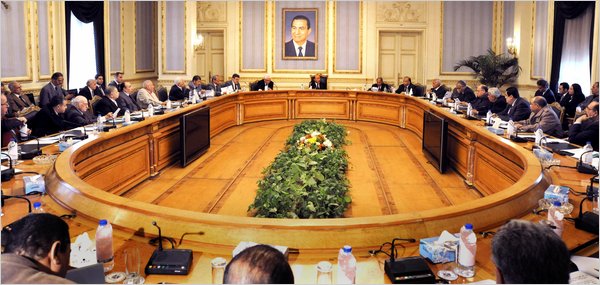
In reality, the Suleiman-Brothers tea party turned out to be nothing more than another stunt staged by Nile TV News. This once interesting cable service was transformed in the last week into a rather Murdochian propaganda unit whose productions are run by the artistic genius of Mubarak’s Presidential Guards. Images of the Suleiman-Brothers tête-à-têtes were broadcast at a time when Suleiman’s legitimacy and sanity were appearing increasingly shaky within Egypt, and when this particular sub-group of the Brothers who represent only one fraction of one faction of the opposition was trying to leverage an unlikely comeback. As reporters obsessed over which Brother was sitting with Suleiman, they continued to ignore or misapprehend the continuing growing power of the movements that had started this uprising. Many progressives continued to think that the US was conspiring with Suleiman to crush all hope – as if America’s puny $1.5 billion in aid (which all must be recycled back as purchases from US military suppliers anyway) really dictates policy for a regime that makes multi-billion dollar deals with Russia, China and Brazil every month, and that has channeled an estimated $40-70 billion into Mubarak’s personal accounts.
Proving Nile TV and the pessimists wrong, 1.5 million people turned out on 7 February -- the biggest mobilization so far in this uprising. Commentators focusing on the Brothers had completely missed the real news of the past two days. The ruling NDP party leadership had been savaged from within. In a desperate attempt to salvage his phantom authority, Mubarak had tossed his son Gamal and a whole class of US-linked businessmen to the lions, forcing them to resign and freezing their assets. And at the same time, Egyptian newspaper El-Masry El-Youm reported that the Muslim Brothers’ Youth and Women’s Wings split off from the main Brothers’ organization to join the leftist 6 April Movement. The men sitting around Suleiman’s table were left without much of a movement behind them.
Below I trace the declining power of the economic and moral politics of this “Businessmen’s Wing” of the Brothers. I map the ascendant socio-political power of a new national-development-oriented coalition of businessmen and military entrepreneurs, as well as the decisive force of micro-enterprise and workers’ organizations consisting of women and youth -- a force that portends well for the future of democracy and socio-economic inclusion in Egypt.
Bands of Brothers
The Muslim Brothers are not a marginal force in Egypt. They are very well organized in every city, and can be credited with providing health, education, legal aid and disaster relief to citizens ignored or neglected by the state. But they are not Egypt’s equivalent of Hizballah or Hamas. As Mona El-Ghobashy has described, in the 1990s the Society of Muslim Brothers made a definite break, abandoning its secretive, hierarchical, shari’a-focused form. Today the Muslim Brothers is a well-organized political party, officially banned but occasionally tolerated. In the past twenty years it has made significant inroads in Parliament via alliances with other parties and by running independent candidates. The Brothers now fully support political pluralism, women’s participation in politics, and the role of Christians and communists as full citizens. However, with the rise of other competing labor, liberal and human-rights movements in Egypt in the 2000s, what one can call the “new old guard” of the Brothers (the ones that emerged in the 1980s) have retained a primary focus on cultural, moral and identity politics. Moral-cultural conservatism is still seen by this group as what distinguishes the Brothers from other parties, a fact they confirmed by appointing a rigid social conservative, Muhammad Badeea, as leader in 2010. This turn was rejected by women and youth in the movement. This socially conservative leaning thus brings the “new old guard” more in line with the moralistic paternalism of Mubarak’s government and set them against the trajectory of new youth, women’s and labor movements. This leads to new possibilities of splits in this organization or for exciting revitalization and reinvention of the Brothers, as Youth and Women’s wings feel drawn toward the 6 April coalition. The moral-cultural traditionalist wing of the “new old guard,” is composed of professional syndicate leaders and wealthy businessmen. In the 1950s-80s, the movement regrouped and represented frustrated elements of the national bourgeoisie. But this class of people has largely been swept up into new opportunities and left the organization. The “new old guard” of the Brothers’ business wing has started to look like a group of retired Shriners, except that in the Middle East, Shriners have stopped wearing fezes.
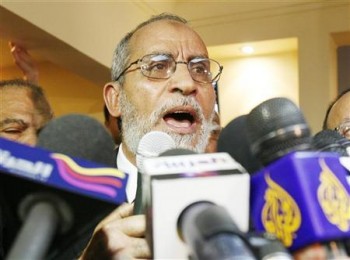
In the past ten years this political force of this particular wing of the Brothers has been partially coopted by Mubarak’s government from two angles. First, Brothers were allowed to enter parliament as independent candidates and have been allowed to participate in the recent economic boom. The senior Brothers now own major cell phone companies and real estate developments, and have been absorbed into the NDP machine and upper-middle class establishment for years. Second, the government wholly appropriated the Brothers’ moral discourse. For the last ten or fifteen years Mubarak’s police-state has stirred moral panics and waved the banner of Islam, attacking single working women, homosexuals, devil-worshipping internet users, trash-recycling pig farmers, rent-control squatters, as well as Baha’i, Christian and Shi’i minorities. In its morality crusades, the Mubarak government burned books, harassed women, and excommunicated college professors. Thus, we can say that Egypt has already experienced rule by an extremely narrow Islamist state – Mubarak’s! Egyptians tried out that kind of regime. And they hated it.

In recent years, as described in the work of Saba Mahmood and Asef Bayat, people have grown disgusted by Mubarak’s politicization of Islam. Egyptians began to reclaim Islam as a project of personal self-governance, ethical piety, and social solidarity. This trend explicitly rejects the political orientation of Islam and explicitly separates itself both from Brothers’ activities and Mubarak’s morality crusades.
The Military as a Populist Middle Class
At one time, the Muslim Brothers represented frustrated, marginalized elements of the middle class. But that story is so 1986! Now there are a wide range of secular (but not anti-religious) groupings that represent emergent economic patterns within the country. Moreover, these groups are swept up in a whirlwind of new political-economic energies coming from new or renewed world influences and investors – Russia, Kazakhstan, Azerbaijan, Israel, Dubai, China, Turkey, and Brazil, as well as the return of remittance flows into the country as Egyptian professionals got swept up in the Emirates’ building and development boom.
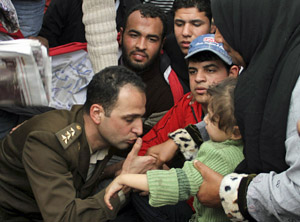
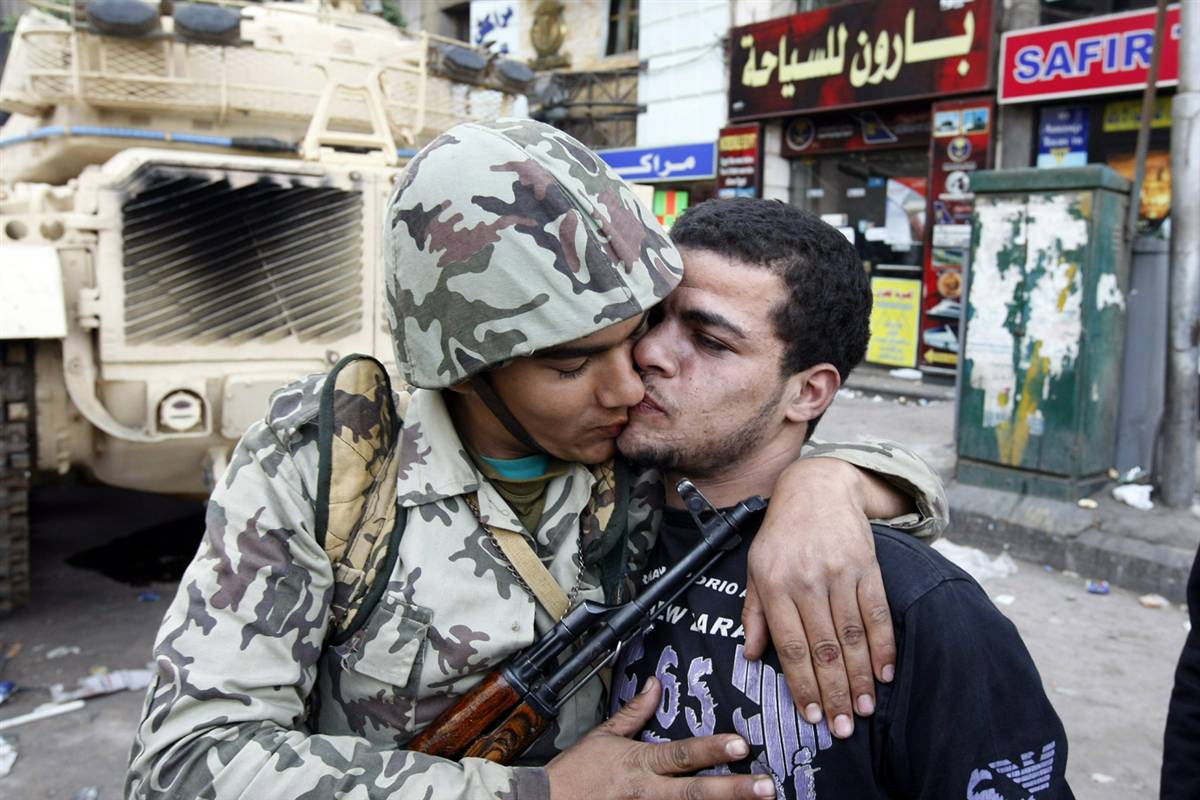
In the context of this new multi-dimensional globalization, in which East/West divides and post-colonial patterns are radically remade, the military have come to be one of the more interesting economic mediators and success stories. The Egyptian military is one of the most interesting and misunderstood economic actors in the country. The military’s economic interests are split in interesting ways. Since the military has been prevented by the Camp David treaty from making war, it has instead used its sovereignty over huge tracks of desert and coastal property to develop shopping malls, gated cities and beach resorts, catering to rich and modest Egyptians, local and international consumers and tourists. Their position vis-à-vis the uprising is thus complicated. They hated the rapacious capitalists around Gamal Mubarak, who sold off national lands, assets and resources to US and European corporations. But the military also wants tourists, shoppers and investors to consume in their multi-billion dollar resorts and venues. The military identifies very strongly with representing and protecting “the people,” but also wants the people to go home and stop scaring away the tourists. The military will continue to mobilize this in-between position in interesting ways in the coming years.
Suleiman’s General Intelligence Services are nominally part of the military, but are institutionally quite separate. Intelligence is dependent on foreign patrons (Israel and the US primarily) and are looked on skeptically by Egyptians. But the actual Army and Air Force are quite grounded in the economic and social interests of national territory. The army’s role in countering Suleiman’s lust for repression was crucial to saving the momentum of this uprising. On 4 February, the day of the most terrifying police/thug brutality in Tahrir Square, many commentators noted that the military were trying to stop the thug attacks but were not being very forceful or aggressive. Was this a sign that the military really wanted the protesters to be crushed? Since then, we have learned that the military in the square were not provisioned with bullets. The military were trying as best they could to battle the police/thugs, but Suleiman had taken away their bullets for fear the military would side with the protesters and use the ammunition to overthrow him.
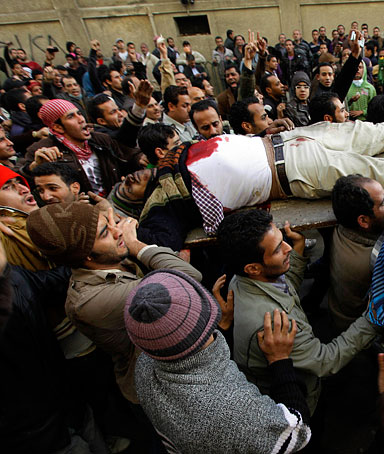
Bullets or no, the military displaced the police, who had stripped off their uniforms and regressed into bands of thugs. Security in Cairo has been taken over by the military, in public spaces, and in residential quarters we witnessed the return of a 21-st century version of futuwwa groups. As Wilson Jacob has described, in the 19th-century futuwwa were icons of working-class national identity and community solidarity in Egypt. Futuwwa were organized groups of young men who defended craft guilds and working-class neighborhoods in Cairo. But the futuwwa reborn on 1 February 2011 are called Peoples’ Committees and include men of all classes and ages, and a few women with butcher knives, too. They stake out every street corner, vigilant for police and state-funded thugs who would try to arrest, intimidate or loot residents. Given the threat of sexualized physical violence from Mubarak’s police/thugs, there is a gender dimension to this reimagining and redeployment of security and military power during this uprising. In the first days of the uprising we saw huge numbers of women participating in the revolt. Then the police/thugs started targeting women in particularly horrifying way, molesting, detaining, raping. And then when the police were driven back, the military and the futuwwa groups took over and insisted that “protecting” the people from thugs involved filtering women and children out of Tahrir and excluding them from public space. But women in this revolt have insisted that they are not victims who need protection, they are the leading core of this movement. On 7 February, women’s groups, including the leftist 6 April national labor movement, anti-harassment, civil rights groups, and the Women’s Wing of the Brothers reemerged in force in downtown Cairo by the hundreds of thousands.
Gutting Gamal’s Globalization
On 28 January the headquarters of Mubarak’s ruling National Democratic Party burned down, and with it, Mubarak’s substantive authority was turned to ashes. The rising military and national-capital interests then spat on those ashes on 5 February. On that day, they ensured that Gamal Mubarak would resign as head of the Political Office of the NDP. In his place, Dr. Hosam Badrawy was named the new Secretary-General of the party. The choice of Badrawy reflects the direction the winds are blowing now. Badrawy holds the dubious honor of being the man who founded Egypt’s first private-sector health-care HMO in 1989. All Egyptians are constitutionally guaranteed access to free, universal health care. But Mubarak, under orders from the IMF, made draconian cuts to the public health service beginning in the 1980s. Badrawy has championed the privatization of health care, and has created a national private health care industry with significant capital and legitimacy. This industry is threatened by global competition and describes itself in nationalistic, paternalistic tones. Gamal Mubarak serving as a vehicle for foreign investment posed a threat to national businessmen like Badrawy. Badrawy also served in the past as the Director of the NDP’s human rights organization, a particularly contradictory job to hold during a time of mass repression and torture.
Naguib Sawiris, the self-proposed chair of the “Transitional Council of Wise Men,” is similar in some ways to Badrawy. Sawiris is a patriotic, successful nationalist businessman. Sawiris heads the largest private-sector company in Egypt, Orascom. This firm has built railways, beach resorts, gated-cities, highways, telecom systems, wind farms, condos and hotels. He is a major Arab world and Mediterranean region financier. He is also the banner carrier for Egypt’s developmentalist nationalists. On 4 February Sawiris released a statement proposing a council of wise men who would oversee Suleiman and the police, and who would lead Egypt through the transition. The proposed council would be a so-called “neutral, technocratic” body that would include Sawiris, along with a couple of non-ideological members of the Muslim Brotherhood’s businessmen’s wing, some strategic-studies experts, and a Nobel Prize winner. Would this Nobel winner be Mohammed ElBaradei, the peace laureate and opposition leader? Nope. They had found an Egyptian laureate in organic chemistry.
Women, Micro-Businesses and Workers
In the context of the relationships described above, we can understand why we witnessed the emergence in the first week of February 2011 of a coalition around nationalist businessmen in alliance with the military – a military who also act like nationalist middle-class businessmen themselves. This group ejected the “crony globalizers” and “barons of privatization” surrounding Gamal Mubarak. Would this group then cement their hold on power, to rule the country with Suleiman as their hammer? No. Other massive social forces were also at work. They are well organized. Legitimacy, organization, new vision and economic power are in their hands. The new nationalist business-military bloc cannot develop the country without their participation and mobilization.
It is crucial to remember that this uprising did not begin with the Muslim Brothers or with nationalist businessmen. This revolt began gradually at the convergence of two parallel forces: the movement for workers’ rights in the newly revived factory towns and micro-sweatshops of Egypt especially during the last two years, and the movement against police brutality and torture that mobilized every community in the country for the last three years. Both movements feature the leadership and mass participation of women (of all ages) and youth (of both genders). There are structural reasons for this.
First, the passion of workers that began this uprising does not stem from their marginalization and poverty; rather, it stems from their centrality to new development processes and dynamics. In the very recent past, Egypt has reemerged as a manufacturing country, although under the most stressful and dynamic of conditions. Egypt’s workers are mobilized because new factories are being built, in the context of a flurry of contentious global investment. Several Russian free-trade zones and manufacturing settlements have opened up, and China has invested in all parts of the Egyptian economy. Brazil, Turkey, the Central Asian Republics and the Gulf Emirates are diversifying their investments. They are moving out of the oil sector and real estate and into manufacturing, piece-goods, informatics, infrastructure, etc. Factories all over Egypt have been dusted off and reopened, or newly built. And all those shopping malls, gated cities, highways and resorts have to be built and staffed by someone. In the Persian Gulf, developers use Bangladeshi, Philippine and other expatriate labor. But Egypt usually uses its own workers. And many of the workers in Egypt’s revived textile industries and piece-work shops are women. If you stroll up the staircases into the large working-class apartment buildings in the margins of Cairo or the cement-block constructions of the villages, you’ll see workshops full of women, making purses and shoes, and putting together toys and computer circuitboards for sale in Europe, the Middle East and the Gulf. These shop workers joined with factory workers to found the 6 April movement in 2008. They were the ones who began the organizing and mobilizing process that led to this uprising in 2011, whose eruption was triggered by Asmaa Mahfouz’ circulating a passionate Youtube video and tens of thousands of leaflets by hand in slum areas of Cairo on 24 January 2011. Ms. Mahfouz, a political organizer with an MBA from Cairo University, called people to protest the next day. And the rest is history.
The economic gender and class landscape of Egypt’s micro-businesses has been politicized and mobilized in very dynamic ways, again with important gender and sexual dimensions. Since the early 1990s, Egypt has cut back welfare and social services to working-class and lower-middle-class Egyptians. As Julia Elyachar has argued, in the place of food subsidies and jobs they have offered debt. Micro-credit loans were given, with the IMF and World Bank’s enthusiastic blessing, to stimulate entrepreneurship and self-reliance. These loans were often specifically targeted toward women and youth. Since economically disadvantaged applicants have no collateral to guarantee these loans, payback is enforced by criminal law rather than civil law. This means that your body is your collateral. The police extract pain and humiliation if you do not pay your bill. Thus the micro-enterprise system has become a massive set of police rackets and “loan shark” operations. Police sexualized brutalization of youth and women became central to the “regulation” of the massive small-business economy. In this context, the micro-business economy is a tough place to operate, but it does shape women and youth into tough survivors who see themselves as an organized force opposed to the police-state. No one waxes on about the blessings of the market’s invisible hand. Thus the economic interests of this mass class of micro-entrepreneurs are the basis for the huge and passionate anti-police brutality movement. It is no coincidence that the movement became a national force two years ago with the brutal police murder of a youth, Khalid Saeed, who was typing away in a small internet café that he partially owned. Police demanded ID and a bribe from him; he refused, and the police beat him to death, crushing his skull to pieces while the whole community watched in horror.

Police demanding bribes, harassing small micro-businesses, and beating those who refuse to submit had become standard practice in Egypt. Internet cafes, small workshops, call-centers, video-game cafes, microbuses, washing/ironing shops, small gyms constitute the landscape of micro-enterprises that are the jobs base and social world of Egypt’s lower middle classes. The so-called “Facebook revolution” is not about people mobilizing in virtual space; it is about Egyptian internet cafes and the youth and women they represent, in real social spaces and communities, utilizing the cyberspace bases they have built and developed to serve their revolt.
The Egyptian Difference
In the case of the Iranian Revolution in the 1970s, the “bazaaris of Tehran” (the medium-sized merchants and shop owners) ended up serving as the crucial “swing vote,” moving the Iranian Revolution from left to right, from a socialistic uprising toward the founding of an Islamic Republic. In the case of Egypt, the social and political force of women and youth micro-entrepreneurs will lead history in the opposite direction. These groups have a highly developed a complex view of the moral posturing of some Islamists, and they have a very clear socio-economic agenda, which appeals to the dynamic Youth Wing of the Brothers. The progressive groups have a linked network of enterprises, factories, identities and passions. They would go to any length to prevent the reemergence of police brutality and moralistic hypocrisy that have ruled them for the past generation. The women and youth behind theses micro-businesses, and the workers in the new Russian, Chinese, Brazilian, Gulf, and Egyptian-financed factories seem to be united. And they grow more so each day.
Micro-entrepreneurs, new workers groups, and massive anti-police brutality organizations obviously do not share the same class position as Sawiris and Badrawi and the rich men in the “Council of the Wise.” Nevertheless, there are significant overlaps and affinities between the interests and politics of nationalist development-oriented groups, the newly entrepreneurial military, and the vitally well-organized youth and women’s social movements. This confluence of social, historical and economic dynamics will assure that this uprising does not get reduced to a photo opportunity for Suleiman and a few of his cronies.
A Cheshire Cat is smiling down on Suleiman’s tea party.